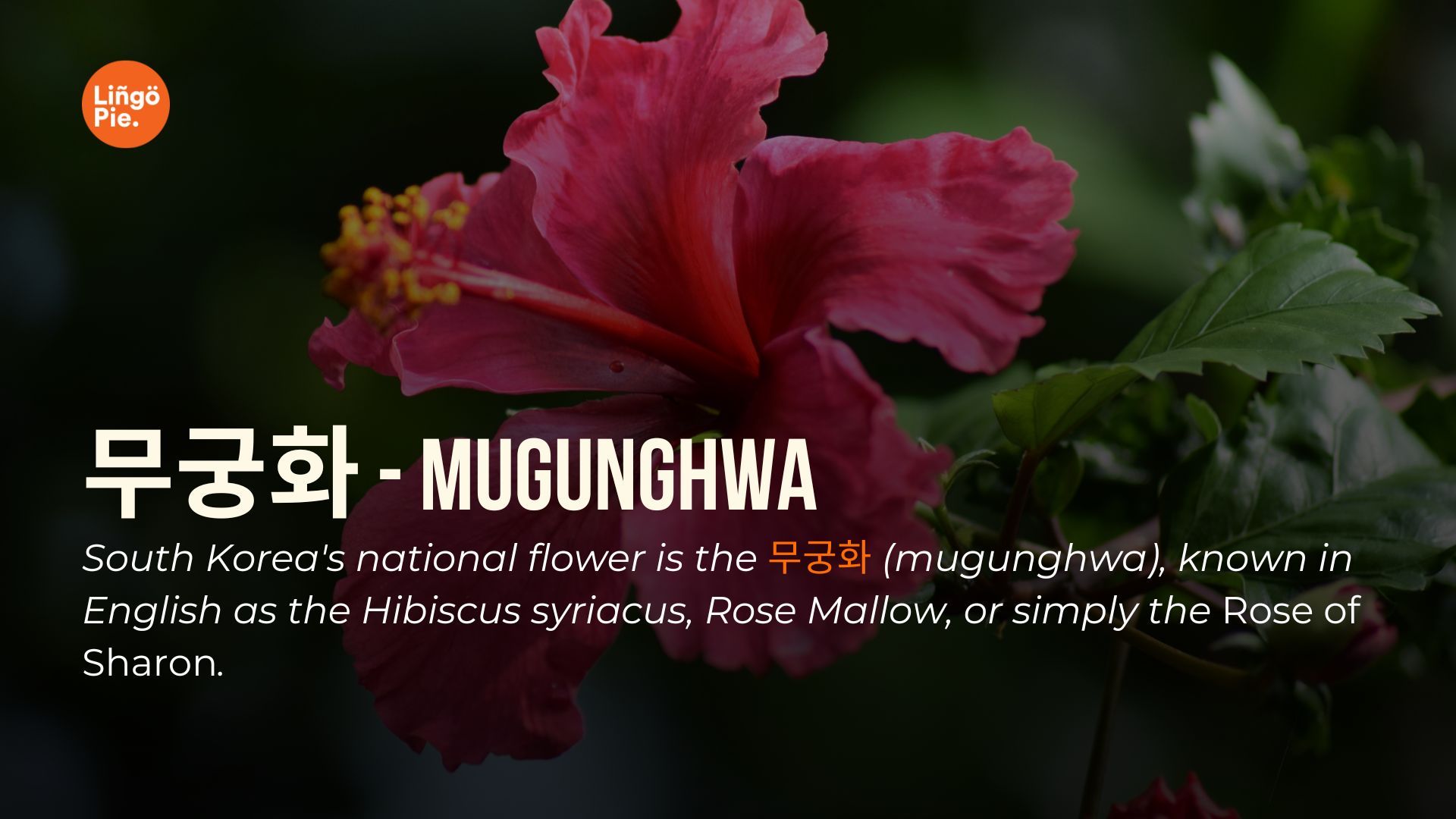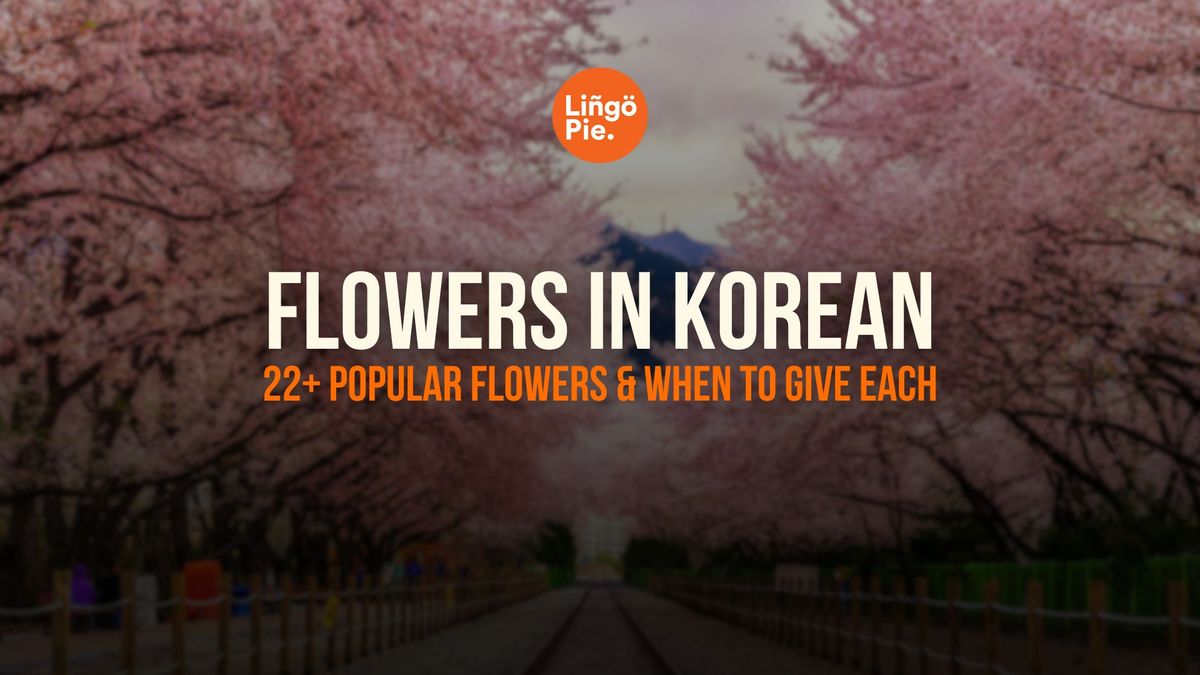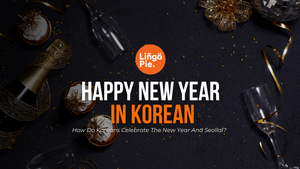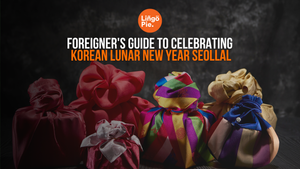Raise your hand if you've ever found yourself swooning over a romantic scene in a K-drama, where the dashing lead surprises the heroine with a stunning bouquet of flowers or 꽃 (Kkot). As a fellow K-drama enthusiast and K-pop fan, I've often daydreamed about receiving a beautiful arrangement from my very own Korean oppa.
But beyond these dreamy scenarios, understanding Korean flower culture can be surprisingly practical. In fact, the floriculture in Korea is expected to grow at an impressive 7.4% CAGR from 2023 to 2033. This flowering boom means two exciting things: first, floral enthusiasts are about to fall even deeper in love with Korean flower culture, and second, a whole bouquet of new job opportunities is sprouting up in this blossoming industry.
So, whether you're dreaming of your own K-drama moment or eyeing a career that's literally growing, understanding Korean flower culture can be pretty handy! In this post, we're going to take a fragrant journey through the most popular flowers in Korea and even learn how to order one.

How To Say Flower In Korean
In Korean, 꽃 (kkot) is the primary word you'll use when talking about flowers in most contexts. However, it's important to note that its pronunciation can change depending on the particles attached to it, due to a feature in Korean phonetics called consonant assimilation:
- Basic form: 꽃 (kkot) - pronounced with a final "t" sound when used alone
- With object marker: 꽃을 (kkocheul)
- With subject marker: 꽃이 (kkochi)
Understanding these variations will help you speak more naturally when discussing flowers in Korean. Let's look at some example sentences:
- "The flowers are beautiful." 꽃이 아름다워요. (Kkochi areumdawoyo.)
- "I bought flowers for my mother." 어머니께 꽃을 샀어요. (Eomeonikke kkocheul sasseoyo.)
- "There are many flowers in the garden." 정원에 꽃이 많아요. (Jeongwone kkochi manayo.)

What is the Korean National Flower?
South Korea's national flower is the 무궁화 (mugunghwa), known in English as the Hibiscus syriacus, Rose Mallow, or simply the Rose of Sharon. This special flower holds a special place in Korean culture, with its name meaning "eternal blossom that never fades."
Blooming from early December until late April, this flower isn't just perfect for the traditional Cocoji practice (flower arrangement)! It also plays a huge role in the Korean history and identity:
- It has been a symbol in Korean culture since before the Gojoseon era, showcasing its long-standing importance.
- The flower represents the strength and independent spirit of the Korean people.
- Interestingly, the mugunghwa is known for its resilience, being resistant to pollution – a characteristic that mirrors the Korean spirit.
- During the Japanese colonial period, Koreans planted these flowers as a form of silent protest, demonstrating its role in preserving national identity.
You might encounter references to the mugunghwa in unexpected places. For instance, fans of the series "Squid Game" might recognize it from the song "The Mugunghwa Flower Is Blooming." There's even a train operated by Korail named Mugunghwa-ho, honoring the national flower.
The flower's significance also extends to official government emblems, flags, and symbols. In fact, it's even mentioned poetically in the South Korean national anthem underlining its importance to the country.
Tip: If you're learning Korean or just want to impress your Korean friends, try this phrase: "무궁화는 대한민국의 국화입니다." (Mugunghwaneun daehanmingugui gukhwaimnida.) This means "The Rose of Sharon is the national flower of South Korea."
Popular Flowers In Korean Culture
While the mugunghwa holds the honor of being the national flower, many other blossoms have found their way into Korean hearts, homes, and traditions. In this section, we'll explore some of the most beloved flowers in Korea, their meanings, and how they're used in everyday life and special events.

벚꽃 (Beotkkot) - Cherry Blossom
Cherry blossoms, or 벚꽃 (beotkkot) in Korean, are one of the most anticipated and beloved flowers in Korea. These delicate pink cherry blossoms bloom in late March to early April, signaling the arrival of spring.
In Korean culture, cherry blossoms symbolize beauty, fragility, and the ephemeral nature of life. Their brief but stunning display serves as a reminder to appreciate life's fleeting moments.
The cherry blossom season in Korea is celebrated with numerous festivals across the country. The most famous are the Jinhae Gunhangje Festival and the Yeouido Spring Flower Festival in Seoul, where visitors can stroll under canopies of blooming cherry trees.
While cherry blossom trees aren't typically given as gifts or used in floral arrangements, many Koreans plan outings or picnics with friends and family to view the blossoms, a tradition known as 꽃놀이 (kkonnori) or "flower viewing."
장미 (Jangmi) - Korean Rose
The rose, known as 장미 (jangmi) in Korean, holds a special place in Korean culture as a symbol of love, passion, and beauty. While not native to Korea, roses have been widely adopted and are now a staple in Korean floristry and gardening.
Roses typically bloom from late spring to early fall in Korea, with peak blooming periods in May and June. They are popular gifts for various occasions, especially romantic ones like Valentine's Day and anniversaries.
In Korea, roses are celebrated during the Rose Festival at Seoul Grand Park, typically held in May. This festival showcases a wide variety of roses and offers visitors the chance to enjoy beautiful rose gardens, participate in cultural events, and even make rose-themed crafts.
| Rose Color | Korean Name | Meaning |
|---|---|---|
| Red | 빨간 장미 (Ppalgan jangmi) | Passionate love, desire |
| Pink | 분홍 장미 (Bunhong jangmi) | Gratitude, admiration, gentleness |
| White | 흰 장미 (Huin jangmi) | Purity, innocence, new beginnings |
| Yellow | 노란 장미 (Noran jangmi) | Friendship, joy (unlike in some Western cultures, it doesn't signify jealousy) |
| Orange | 주황 장미 (Juhwang jangmi) | Enthusiasm, desire |
| Purple | 보라 장미 (Bora jangmi) | Love at first sight, enchantment |
| Blue | 파란 장미 (Paran jangmi) | Miracle, impossibility (as naturally blue roses don't exist) |
Oh and don't be surprised if ever you see Korean skincare products with rose extracts! They are just super popular based on Korean beauty standards!

동백꽃 (Dongbaekkkot) - Camelia
Ever watched the hit 2019 series, "When the Camellia Blooms" or 동백꽃 필 무렵 (Dongbaek-kkot pil muryeop)? If yes, then we bet you already know that this flower blooms from late autumn to early spring and is often associated with the southern regions of Korea (Jeju Island).
In Korean culture, camellias symbolize faithfulness, longevity, and perseverance due to their ability to bloom in the cold winter months. The flower's vibrant colors against the stark winter landscape make it a popular subject in Korean art and literature. Just note that while they are not commonly given as cut flowers, they are usually gifted as potted plants and are used for traditional Korean medicine.
모란 (Moran) - Peony
The peony, known as 모란 (moran) in Korean, is a flower of great significance in Korean culture, often referred to as the "King of Flowers." Blooming in late spring to early summer, typically from April to June, peonies are admired for their large, lush blossoms and rich colors.
In Korean tradition, peonies symbolize wealth, honor, and feminine beauty. They're also associated with good fortune and are believed to bring prosperity to homes and businesses.
In traditional Korean gardens, peonies are often planted alongside other auspicious plants like bamboo and pine trees, creating a harmonious and prosperous environment. The locals also believe that the combination of different colored peonies can create even more nuanced meanings, often used in art and decorative arrangements to convey complex wishes or sentiments.
| Peony Color | Korean Name | Meaning |
|---|---|---|
| Red | 붉은 모란 (Bulgeun moran) | Wealth, prosperity, good fortune |
| Pink | 분홍 모란 (Bunhong moran) | Romance, feminine beauty, grace |
| White | 흰 모란 (Huin moran) | Purity, nobility, aristocratic elegance |
| Yellow | 노란 모란 (Noran moran) | Rarity, imperial status (historically reserved for royalty) |
| Purple | 보라 모란 (Bora moran) | Dignity, high social status |

해바라기 (Haebaragi) - Sunflower
The name "haebaragi" literally means "facing the sun," reflecting the flower's heliotropic nature. As seen in Korean shows, sunflowers are usually given to a person you like as it symbolize adoration, loyalty, and happiness.
Sunflowers have gained popularity in recent years, leading to the establishment of several sunflower festivals across Korea. The most famous is the Gyeongju Sunflower Festival, usually held in August, where visitors can walk through vast fields of sunflowers and enjoy various cultural activities.
자스민 (Jaseumin) - Jasmine
Jasmine, known as 자스민 (jaseumin) in Korean, is a delicate and fragrant flower that has found its place in Korean culture as it is associated with purity, grace, and sensuality. The flower typically blooms from late spring to early fall, with its peak blooming period in the summer months of June to August.
Unlike some other flowers in Korea, jasmine doesn't have specific festivals dedicated to it. However, it's gaining popularity in Korean gardens and is often used in aromatherapy and skincare products. Jasmine tea, while not as common as in some other Asian countries, is also becoming more popular in Korea for its calming properties.
As a gift, jasmine plants are sometimes given to express wishes for peace and harmony, particularly in new homes or offices.
매화 (Maehwa) - Plum Blossoms
Plum blossoms, known as 매화 (maehwa) in Korean, symbolize perseverance, hope, and renewal. Their ability to bloom in the cold is seen as a metaphor for resilience and the promise of new beginnings. Additionally, the plum blossom's five petals are sometimes associated with the five blessings of longevity, wealth, health, love of virtue, and peaceful death.
In Asian art and literature, plum blossoms are often depicted alongside the pine and bamboo as part of the "Three Friends of Winter," representing steadfastness and integrity.
유채꽃 (Yuchaekkot) - Canola Flowers
These flowers, also called rapeseed flowers, typically bloom from late March to mid-April, coinciding with the arrival of warmer weather. While not traditionally significant in ancient Korean folklore, canola flowers are still believed by the locals to symbolize vitality, abundance, and the exuberance of spring.
The most famous place to see canola flowers in Korea is Jeju Island, which hosts the annual Jeju Canola Flower Festival, usually held in April. This festival attracts thousands of visitors who come to walk through the golden fields and enjoy various cultural events.

백합 (Baekhab) - Lily
In Korea, lilies symbolize chastity, innocence, and motherhood. They are also associated with the restoration of innocence in Buddhist traditions, making them a flower of spiritual significance. Today, lilies are popular as cut flowers for bouquets, especially for weddings and Mother's Day because they often represent the virtues of modesty and devotion.
| Lily Color | Korean Name | Meaning |
|---|---|---|
| White | 흰 백합 (Huin baekhab) | Purity, innocence, heavenly beauty |
| Pink | 분홍 백합 (Bunhong baekhab) | Femininity, admiration, prosperity |
| Yellow | 노란 백합 (Noran baekhab) | Thankfulness, desire for enjoyment |
| Orange | 주황 백합 (Juhwang baekhab) | Passion, confidence |
| Red | 붉은 백합 (Bulgeun baekhab) | Love, passion (less common in Korea) |
| Stargazer Lily | 별백합 (Byeolbaekhab) | Ambition, encouragement |
연꽃 (Yeonkkot) - Lotus Flowers
These elegant flowers bloom from late June to early August, transforming ponds and lakes into beautiful displays of pink and white. In Korean Buddhist tradition, the different stages of the lotus flower's growth are often used as metaphors for the stages of enlightenment. The closed bud represents potential, while the fully bloomed flower symbolizes full enlightenment. This makes the lotus a powerful symbol in Korean spiritual and philosophical contexts.
| Lotus Color | Korean Name | Meaning |
|---|---|---|
| Pink | 분홍 연꽃 (Bunhong yeonkkot) | Buddha's glory, historical legacy |
| White | 흰 연꽃 (Huin yeonkkot) | Purity of mind and spirit, perfection |
| Red | 붉은 연꽃 (Bulgeun yeonkkot) | Compassion, love (less common) |
| Blue | 파란 연꽃 (Paran yeonkkot) | Wisdom, knowledge (rare in Korea) |
| Purple | 보라 연꽃 (Bora yeonkkot) | Mysticism, spirituality |
Other Flowers In Korean
While we've explored some of the most popular flowers in Korean culture, the floral landscape of South Korea is as diverse as it is beautiful. To help expand your knowledge about Korean flowers, I rounded up below flowers that can be used for other special occasions.
| English Name | Korean Name | Romanization | Meaning/Significance | Occasions to Give |
|---|---|---|---|---|
| Orchid | 난초 | Nancho | Refinement, luxury | Business openings, congratulations on promotions |
| Chrysanthemum | 국화 | Gukhwa | Longevity, integrity | Celebrations for elders, academic achievements |
| Carnation | 카네이션 | Kaneisyeon | Mother's love | Parents' Day, Mother's Day |
| Dahlia | 다알리아 | Daalia | Dignity, elegance | Expressing admiration, graduations |
| Tulip | 튤립 | Tyulip | Perfect love, fame | Confessions of love, celebrating success |
| Hydrangea | 수국 | Suguk | Gratitude, heartfelt emotions | Thank you gestures, apologies |
| Azalea | 진달래 | Jindalrae | Passion, temperance | Spring celebrations, homecomings |
| Iris | 붓꽃 | Butkkot | Good news, loyalty | Welcoming new beginnings, friendship anniversaries |
| Daffodil | 수선화 | Suseonhwa | Respect, regard | Teacher's Day, expressing admiration |
| Forget-me-not | 물망초 | Mulmangcho | True love, memories | Anniversaries, farewells |
| Lavender | 라벤더 | Labendeo | Devotion, purity | Weddings, housewarming gifts |
| Magnolia | 목련 | Mogryeon | Nobility, perseverance | Congratulations on overcoming challenges |
| Aster | 과꽃 | Gwakkot | Patience, elegance | Expressing support during difficult times |
| Gerbera | 거베라 | Geobera | Cheerfulness, innocence | Cheering up a friend, children's birthdays |
Remember, while these guidelines are generally observed, personal preferences and the specific relationship between the giver and receiver also play a significant role in flower gifting in Korea.

How To Order Flowers In Korean
Ordering flowers in Korean can be a great way to practice your language skills while participating in local culture. Whether you're buying flowers for a special occasion or simply to brighten up your space, here's a simple guide to help you order flowers in Korean.
Basic Sentence Structure: "[Flower name] 주문하고 싶어요." (jumonhago sipeoyo). This means "I would like to order [flower name]."
Here's how to use this structure:
- Start with the flower name in Korean.
- Add "주문하고 싶어요" (jumonhago sipeoyo) after the flower name.
Examples:
- To order roses: "장미 주문하고 싶어요." (Jangmi jumonhago sipeoyo)
- To order sunflowers: "해바라기 주문하고 싶어요." (Haebaragi jumonhago sipeoyo)
Remember to speak politely and use a friendly tone. Many florists in Korea, especially in tourist areas, may speak some English, but attempting to order in Korean is often appreciated and can enhance your cultural experience. To help you out further, be sure to use these Korean phrases as well:
| Scenario | Korean Phrase | English Translation |
|---|---|---|
| To specify the number of flowers | "[Number] 송이의 [Flower name] 주문하고 싶어요." | "I'd like to order [Number] [Flower name]." |
| Example | "다섯 송이의 장미 주문하고 싶어요." (Daseot song-ui jangmi jumonhago sipeoyo) | "I'd like to order five roses." |
| To ask about the price | "[Flower name] 얼마예요?" (eolmayeyo?) | "How much are the [flower name]?" |
| To request a bouquet | "[Flower name] 꽃다발 주문하고 싶어요." (kkotdabal jumonhago sipeoyo) | "I'd like to order a bouquet of [flower name]." |
| To ask for a recommendation | "어떤 꽃을 추천하세요?" (Eotteon kkocheul chucheonhaseyo?) | "What flowers do you recommend?" |
Flower Etiquette In Korea
Do's: Understanding the proper way to give flowers in Korea can significantly enhance your social interactions and show respect for local customs.
| Action | Cultural Significance |
|---|---|
| Give flowers in odd numbers (except 3) | Odd numbers are considered lucky in Korean culture |
| Present 무궁화 (mugunghwa) for patriotic events | It's the national flower, symbolizing Korean resilience |
| Offer 난초 (nancho, orchids) for business openings | Symbolizes luxury and success in Korean business culture |
| Give pink or red carnations on Parents' Day | Represents parental love in Korea |
| Present a bouquet of roses for romantic gestures | Red roses are universally romantic in Korea |
| Offer sunflowers to cheer someone up | Represents positivity and good energy in Korean sentiment |
| Give lilies for important life events (weddings, graduations) | Symbolizes purity and new beginnings in Korean culture |
Don'ts: Worried about cultural misunderstandings or unintentionally offending someone? Here are the points you need to avoid when giving flowers in Korea.
| Action to Avoid | Cultural Reason |
|---|---|
| Don't give flowers in even numbers | Even numbers are used for funerals in Korea |
| Avoid giving white chrysanthemums casually | They're strictly for funerals in Korea |
| Don't give potted plants to the elderly | Can imply you want them to 'stay rooted' or not travel |
| Avoid cacti or thorny plants as gifts | Seen as prickly and unwelcoming in Korean culture |
| Don't mix 패랭이꽃 (paeraengi-kkot, carnations) with other flowers | They're specifically for Parents' Day in Korea |
| Avoid yellow flowers in romantic contexts | Can symbolize infidelity in Korean flower language |
| Don't give flowers with exposed stems | Wrapped bouquets are preferred for their neat appearance |
Remember, while these guidelines are generally observed in Korea, personal preferences can vary. When in doubt, consult with a local Korean florist or a culturally knowledgeable friend to ensure your floral gift conveys the right message in its specific context.
Vocabulary Related To Flowers In Korean
Expanding your Korean flower vocabulary beyond just the names of flowers can greatly enhance your ability to discuss and appreciate floral beauty in Korean culture. The following table includes essential vocabulary related to flowers, their parts, and common floral contexts.
| English | Korean | Romanization | Usage Example |
|---|---|---|---|
| Flower | 꽃 | Kkot | 이 꽃이 정말 예뻐요. (This flower is really pretty.) |
| Petal | 꽃잎 | Kkonnip | 장미 꽃잎이 떨어졌어요. (Rose petals have fallen.) |
| Stem | 줄기 | Julgi | 이 꽃의 줄기가 굵어요. (This flower's stem is thick.) |
| Leaf | 잎 | Ip | 이 식물의 잎이 초록색이에요. (This plant's leaves are green.) |
| Bud | 봉오리 | Bong-ori | 튤립 봉오리가 막 피기 시작했어요. (The tulip buds have just started to bloom.) |
| Bloom | 피다 | Pida | 봄에 꽃들이 피기 시작해요. (Flowers start to bloom in spring.) |
| Garden | 정원 | Jeongwon | 우리 집 정원에 많은 꽃이 있어요. (There are many flowers in our garden.) |
| Bouquet | 꽃다발 | Kkotdabal | 생일 선물로 꽃다발을 받았어요. (I received a bouquet as a birthday gift.) |
| Vase | 꽃병 | Kkotbyeong | 꽃을 꽃병에 꽂았어요. (I put the flowers in a vase.) |
| Florist | 꽃집 | Kkotjip | 근처 꽃집에서 장미를 샀어요. (I bought roses at a nearby florist.) |
| To plant | 심다 | Simda | 정원에 튤립을 심었어요. (I planted tulips in the garden.) |
| To water | 물을 주다 | Mureul juda | 매일 꽃에 물을 줘요. (I water the flowers every day.) |
| Fertilizer | 비료 | Biryo | 꽃에 비료를 줘서 더 잘 자라요. (The flowers grow better when given fertilizer.) |
| Fragrance | 향기 | Hyanggi | 이 꽃의 향기가 좋아요. (The fragrance of this flower is nice.) |
| In full bloom | 만개하다 | Mangaehada | 벚꽃이 만개했어요. (The cherry blossoms are in full bloom.) |
Learn Korean With Lingopie
By learning these floral terms and their cultural significance, you're not just expanding your Korean vocabulary—you're gaining deeper insight into the heart of Korean traditions and social customs. To see these words and phrases in action, consider using a language-learning platform like Lingopie.
With Lingopie, you can watch Korean movies and TV shows with interactive subtitles, allowing you to hear how native speakers use these floral terms in context. Whether it's a romantic drama featuring a bouquet of roses or a family sitcom discussing garden plans, you'll encounter these flower-related words in natural, everyday conversations.
Curious? Try Lingopie for FREE now!









